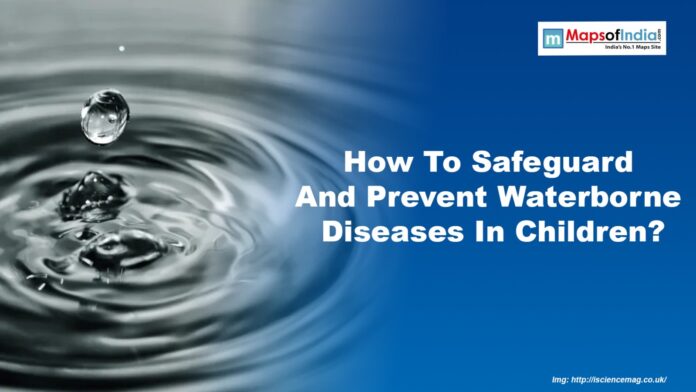Waterborne diseases remain a significant health concern for children worldwide. These illnesses, which spread through contaminated water, can have serious consequences for young ones whose immune systems are still developing. As parents and caregivers, it’s vital to understand how to shield children from these preventable ailments.
This guide aims to provide practical, evidence-based information on safeguarding children against waterborne illnesses. We’ll explore the common causes, recognisable symptoms, and effective preventive measures that can help ensure the health and well-being of our children.
The Nature Of Waterborne Diseases In Children
Waterborne diseases occur when harmful microorganisms in water are ingested or come into contact with the body. Children face a higher risk due to their still-developing immune systems and frequent exposure to water during play and daily activities. Several waterborne illnesses commonly affect children, including diarrhoeal diseases, cholera, typhoid fever, and various parasitic infections. If left untreated, these conditions can lead to severe health complications such as dehydration and malnutrition, potentially endangering a child’s life.
Identifying The Warning Signs
Early detection of waterborne diseases is crucial for effective treatment. Parents and caregivers should be alert to common symptoms, including persistent diarrhoea, abdominal cramps, nausea, vomiting, fever, unusual fatigue, and headaches. It’s important to note that symptoms can vary depending on the specific pathogen involved.
If a child exhibits any of these symptoms, especially after consuming water from an unfamiliar source, it’s advisable to seek medical attention promptly. Quick action can prevent the illness and reduce the risk of complications.
Ensuring Access To Safe Drinking Water
Providing clean, safe drinking water is the cornerstone of preventing waterborne diseases. Tap water is often safe for consumption in areas with reliable water treatment systems. However, additional precautions are necessary in regions where water quality is uncertain.
Boiling water for at least one minute effectively eliminates most harmful microorganisms. Alternatively, certified water filters or purchasing bottled water from reputable sources can help ensure water safety. It’s also important to store water properly in clean, covered containers to prevent contamination after treatment.
The Importance Of Good Hygiene Practices
Teaching and reinforcing good hygiene habits is crucial in preventing the spread of waterborne diseases. Regular handwashing with soap and clean water, especially before eating and after using the toilet, is a simple yet powerful preventive measure. Children should be taught to avoid putting unwashed hands or objects in their mouths and to use clean utensils for eating and drinking.
Proper oral hygiene is also important, as some waterborne pathogens can spread through contaminated toothbrushes. Ensure children brush their teeth with safe water and replace toothbrushes regularly.
Safe Food Handling And Preparation
Food can also be a vector for waterborne illnesses if not handled properly. Washing fruits and vegetables thoroughly with clean water before consumption is essential. When preparing meals, cooking food thoroughly, especially meat and seafood, is important to kill any potential pathogens. When dining out, particularly in areas with questionable water quality, it is advisable to avoid raw or undercooked foods. Keeping food covered can also prevent insect contamination, which can carry waterborne pathogens.
Staying Safe During Water Activities
Children enjoy playing in the water, but certain precautions are necessary to minimise risks. Adult supervision is crucial during water play to prevent accidental ingestion of potentially contaminated water. After swimming in pools, lakes, or the sea, children should shower with clean water to rinse off any harmful microorganisms that may be present on their skin.
It’s also important to teach children to avoid swallowing water while swimming. Stagnant water bodies, which can harbour high concentrations of harmful microorganisms, should be avoided altogether.
Community-wide Efforts For Water Safety
While individual actions are essential, community-wide efforts are often necessary to ensure widespread access to safe water. Supporting and participating in local water treatment and sanitation initiatives can help create a safer environment for all children in the community.
It’s also crucial to stay informed about water quality issues in your area and follow any advisories issued by local health authorities. During natural disasters or other events that may compromise water safety, it’s important to follow official guidelines for water treatment and use.
Protecting children from waterborne diseases requires a multifaceted approach combining awareness, preventive measures, and good hygiene practices. We can significantly reduce the risk of these illnesses by ensuring access to clean water, teaching and reinforcing proper hygiene habits and taking necessary precautions during water-related activities.
Parents and caregivers can play a crucial role in safeguarding children’s health by staying informed and implementing these guidelines. However, if you suspect a child has contracted a waterborne illness, it’s important to seek medical help promptly. With vigilance and proper care, we can help ensure our children grow up healthy and protected from the threats posed by waterborne diseases.




